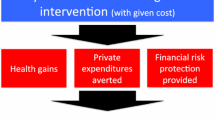Abstract
I present evidence on the cost-effectiveness of 76 regulatory actions promulgated by the Federal government from 1967 to 2001 by updating similar work published by the author in 1986. The paper first responds to several critiques of the original article recently published in prominent law journals by showing that most of the specific criticism is based on misrepresentations and mistakes. Wide differences in cost-effectiveness indicate we could save lives more effectively. Regulations aimed at reducing safety and cardiovascular risks have been more cost-effective than regulations aimed at reducing cancer risks. I suggest several potential regulations that could save lives more cost-effectively than the vast majority of regulations issued to date.
Similar content being viewed by others
References
Arrow, Kenneth et al. (1996). "It there a Role for Benefit-Cost Analysis in Environmental, Health, and Safety Regulation?" Science 272, 221.
Breyer, Stephen. (1993). Breaking the Vicious Circle: Toward Effective Risk Regulation. Cambridge: Harvard University Press.
Broder, Ivy and John Morrall. (1983). "The Economic Basis for OSHA's and EPA's Generic Carcinogen Regulations." In Richard Zeckhauser and Derek Leebaert (eds.), What Role for Government? Durham: Duke University Press.
Donohue, John. (1999). "Why We Should Discount the Views of Those Who Discount Discounting," The Yale Law Journal 108, 1901–1910.
Farrow, Scott and Michael Toman. (1999). "Using Environmental Benefit-Cost Analysis to Improve Government Performance," Environment 41, 12–37.
Farrow, Scott. (2000). "Improving Regulatory Performance: Does Executive Office Oversight Matter?" AEIBrookings Joint Center for Regulatory Studies.
Garber, Alan. (1999). "Advances in Cost-Effectiveness Analysis of Health Interventions," National Bureau of Economic Research, Working Paper 7198.
Hahn, Robert. (1999). "Regulatory Reform: Assessing the Government's Numbers," AEI-Brookings Joint Center for Regulatory Studies.
Hahn, Robert, Randall Lutter, and W. Kip Viscusi. (2000). "Do Federal Regulations Reduce Mortality?" Washington: AEI-Brookings Joint Center for Regulatory Studies.
Health Canada. (2001). "Priority Substance List Assessment Report—Formaldehyde."
Heinzerling, Lisa. (1998). "Regulatory Costs of Mythic Proportions," The Yale Law Journal 107, 1981–2070.
Heinzerling, Lisa and Frank Ackerman. (2002). "The Humbugs of the Anti-Regulatory Movement," Cornell Law Review 87, 648–670.
Hu, F. et al. (2002). "Fish and Omega-3 Fatty Acid Intake and Risk of Coronary Heart Disease inWomen," Journal of the American Medical Association 287, 1815–1821.
Kniesner, Thomas and W. KipViscusi. (2003). "Why Relative Economic Position Does Not Matter:ACost-Benefit Analysis," Yale Journal of Regulation 20, 1–24.
Lutter, Randall and John Morrall. (1994). "Health-Health Analysis: A New Way to Evaluate Health and Safety Regulation," Journal of Risk and Uncertainty 8, 43–66.
Lutter, Randall, John Morrall, and W. Kip Viscusi. (1999). "The Cost-Per-Life-Saved Cutoff for Safety-Enhancing Regulations," Economic Inquiry 37, 599–608.
Lutter, Randall and Katherine Tucker. (2003). "Unacknowledged Health Benefits of Genetically Modified Food: Salmon and Heart Disease Deaths," AgBioForum 5, 59–64.
McGarity, Thomas. (1998). "A Cost-Benefit State," Administrative Law Review 50, 7–79.
McGarity, Thomas and Ruth Ruttenberg. (2002). "Counting the Cost of Health, Safety, and Environmental Regulation," Texas Law Review 80, 1997–2057.
Mendelhoff, John. (1988). The Dilemma of Toxic Substance Regulation. Cambridge: MIT Press.
Morgenstern, Richard (ed.). (1997). Economic Analysis at EPA: Assessing Regulatory Impact. Washington: Resources for the Future.
Morrall, John. (1986). "A Review of the Record," Regulation 10, 25–34.
Nichols, Albert and Richard Zeckhauser. (1986). "The Perils of Prudence: How Conservative Risk Assessments Distort Regulation," Regulation 10, 13–24.
Occupational Safety and Health Administration. (1976). Inflationary Impact Statement: Coke Oven Emissions.
Office of Management and Budget. (1986). "Comments onOSHA's Proposed Rulemaking: Occupational Exposure to Formaldehyde," (Available from the author).
Office of Management and Budget. (1990). 1990-1991 Regulatory Program of the United States Government Washington: GPO.
Office of Management and Budget. (1992). 1991-1992 Regulatory Program of the United States Government.
Office of Management and Budget. (1992). 1991-1992 Regulatory Program of the United States Government. Washington: GPO.
Office of Management and Budget. (2002a). Analytical Perspectives Budget of the United States Government FY 2003. Washington: GPO.
Office of Management and Budget. (2002b). Stimulating Smarter Regulation: 2002 Report to Congress on the Cost and Benefits of Regulations.
Office of Management and Budget. (2003). “Draft 2003 Report to Congress and the Cost and Benefits of Federal Regulations,” Federal Register 68, 5513–5526.
Page, R. et al. (2000). “Use of Automated External Defibrillators by a US Airline,” New England Journal of Medicine 343, 1210–1216.
Parker, Richard. (2003). “Grading the Government,” University of Chicago Law Review, forthcoming.
Redmond, C.K. et al. (1972). “Long-term Mortality Study of Steelworkers-VI. Mortality from Malignant Neoplasms Among Coke Oven Workers,” Journal of Occupational Medicine 14, 621–629.
Seong, S. Kyung and John Mendelhoff. (2002). "Assessing the Accuracy of OSHA's Estimation of the Benefit of Safety Standards," University of Pittsburgh.
Sunstein, Cass. (1996). "Health-Health Tradeoffs," University of Chicago Law Review 63, 1533–1548.
Tengs, Tammyet al. (1995). "Five-Hundred Life-Saving Interventions and Their Cost-Effectiveness," Risk Analysis 15, 369–390.
Viscusi, W. Kip. (1974). "Mortality Effects of Regulatory Costs and Policy Evaluation Criteria," RAND Journal of Economics 25, 94–109.
Viscusi, W. Kip. (1992). Fatal Tradeoffs: Public and Private Responsibilities for Risk. NewYork: Oxford University Press.
Viscusi, W. Kip, John Hakes, and Alan Carlin. (1997). "Measures of Mortality Risk," Journal of Risk and Uncertainty 14, 213–233.
Viscusi, W. Kip and Joseph Aldy. (2003). "The Value of Statistical Life: A Critical Review of Market Estimates Throughout the World," Journal of Risk and Uncertainty 27(1), 5–76.
Zeckhauser, Richard and W. Kip Viscusi. (1990). "Risk Within Reason," Science 248, 559–563.
Author information
Authors and Affiliations
Corresponding author
Rights and permissions
About this article
Cite this article
Morrall III, J.F. Saving Lives: A Review of the Record. Journal of Risk and Uncertainty 27, 221–237 (2003). https://doi.org/10.1023/A:1025841209892
Issue Date:
DOI: https://doi.org/10.1023/A:1025841209892




